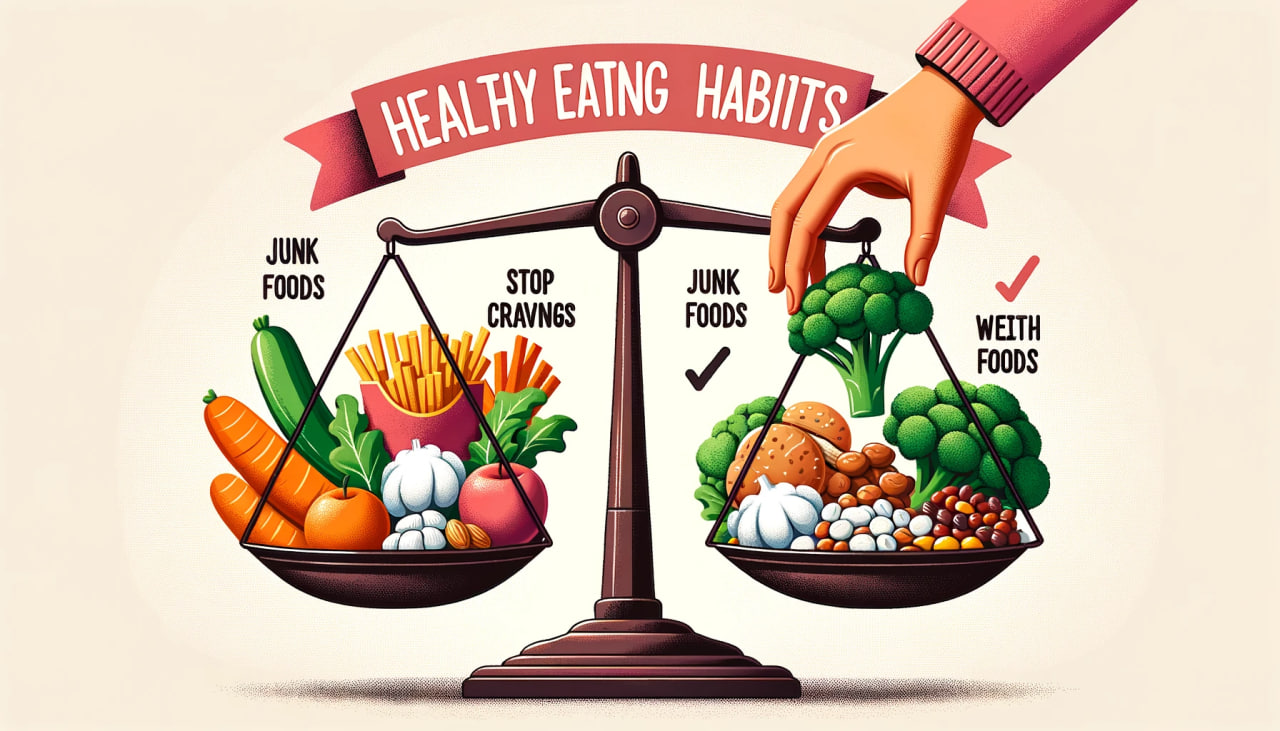We all know the struggle of losing weight and staying on track with our goals. One of the biggest challenges in this journey is dealing with cravings for unhealthy foods, especially junk food and sugar. These cravings can be overridden, often leading to giving in and derailing our progress. However, we can overcome these cravings and healthy eating habits with the right strategies and mindset. In this blog post, we will discuss five effective ways to stop cravings for junk food and sugar, helping you stay on track with your weight loss goals and achieve a healthier lifestyle.
Understanding the Impact of Junk Food and Sugar on Your Body
Junk food and sugar may taste delicious, but their impact on our bodies is far from pleasant. When we consume junk food and sugary treats, our bodies experience a rapid spike in blood sugar levels, leading to a surge of energy followed by a crash. This rollercoaster effect can leave us feeling lethargic and drained. Additionally, these foods are often high in calories and low in nutrients, leading to weight gain and an increased risk of chronic diseases such as obesity, diabetes, and heart disease.
Not only do junk food and sugar wreak havoc on our physical health, but they can also negatively impact our mental and emotional well-being. Studies have shown that excessive sugar consumption can contribute to mood swings, irritability, and even depression. The addictive nature of junk food and sugar can also make it difficult to control our cravings and lead to a cycle of overeating and guilt.
Identifying and Recognizing Your Cravings
Understanding our cravings is crucial in overcoming them and staying on track with our healthy eating goals. Passions can manifest in various ways, such as a sudden desire for a specific type of food or a constant thought about indulging in unhealthy snacks. Identifying and recognizing these cravings is essential to understand our triggers better and finding effective ways to combat them.
Start by keeping a food journal to track your cravings. Write down the time, location, and circumstances surrounding each desire. This will help you identify patterns and potential triggers, such as stress, boredom, or social situations. Also, please pay attention to the foods you crave and their associated emotions. Are you craving something sweet when you’re feeling sad or chocolate when you’re stressed?
Strategies to Combat Junk Food and Sugar Cravings
Are you tired of constantly battling with cravings for junk food and sugar? You’re not alone. These cravings can be potent and complex to resist, but with the right strategies, you can overcome them and stay on track with your weight loss goals.
One effective strategy is to find healthier alternatives to satisfy your cravings. For example, if you’re craving something sweet, try reaching for a piece of fruit or a small square of dark chocolate. These options can provide a satisfying taste while also offering essential nutrients.
Another strategy is to distract yourself when cravings hit. Engage in activities that take your mind off food, such as walking, calling a friend, or reading a book. By focusing on something else, you can redirect your attention away from the craving and decrease its intensity.
Additionally, it’s essential to address the underlying causes of your cravings. Sometimes, cravings can be a result of emotional or stress-related factors. By finding healthy ways to cope with these emotions, such as practicing mindfulness or engaging in stress-relieving activities, you can reduce the frequency and intensity of your cravings.
Healthy Substitutes for Common Junk Food and Sugar Cravings
Cravings for junk food and sugar can be a significant roadblock on your weight loss journey, but healthier alternatives can satisfy your cravings without derailing your progress. When you long for something sweet, reach for a piece of fruit instead. Not only will you satisfy your sweet tooth, but you’ll also benefit from the vitamins, minerals, and fiber that fruits provide. Opt for air-popped popcorn or roasted chickpeas if you’re craving something crunchy and salty.
These snacks are low in calories and packed with fiber, making them a great alternative to chips or pretzels. For those chocolate cravings, try a small square of dark chocolate. It’s rich in antioxidants and can satisfy your hunger while being a healthier choice. By finding healthier substitutes for your favorite junk foods and sugary treats, you can stay on track with your weight loss goals while enjoying delicious snacks.
How to Stay Motivated and On-track with Your Weight Loss Goals
Staying motivated and on track with your weight loss goals can be challenging, but it is crucial for long-term success. Here are some tips to help you stay motivated and committed to your journey.
First, set realistic and achievable goals. Break down your weight loss journey into smaller, manageable milestones, and celebrate each milestone as you achieve it. This will keep you motivated and give you a sense of accomplishment.
Next, find a support system. Surround yourself with like-minded individuals who have similar goals and are on a similar journey. Join a weight loss group or find an accountability partner to support, encourage, and motivate.
It’s also essential to track your progress. Keep a journal or use a tracking app to monitor your food intake, exercise, and weight loss. Seeing your progress in black and white can be incredibly motivating and help you focus on your goals.
Don’t forget to reward yourself along the way. Treat yourself to non-food rewards for reaching milestones or sticking to your healthy eating habits. This could be a new workout outfit, a spa day, or a day off to relax and recharge.
Managing Your Environment for Health
Creating a healthy environment is essential for maintaining your weight loss goals and overcoming cravings for junk food and sugar. By making a few simple changes to your surroundings, you can set yourself up for success and stay on track with your healthy eating habits.
Start by decluttering your pantry and refrigerator. Avoid tempting junk food and replace it with healthier options such as fruits, vegetables, and whole grains. Having these nutritious foods readily available will make it easier to make healthier choices when cravings strike.
Next, organize your kitchen and make it a space that supports your goals. Keep healthy snacks within reach and store them in clear containers to make them more visible. Create a designated area for meal prep and invest in storage containers that make it easy to portion out your meals and snacks.
Additionally, consider the layout of your kitchen and dining area. Arrange your kitchen in a way that encourages cooking and minimizes distractions. Create a comfortable and inviting space for eating meals, free from distractions like electronics or work-related items.
Small Changes, Big Results: Tips for Incorporating Healthier Eating Habits
Making small changes to your eating habits can yield significant results in your weight loss journey. Here are some simple tips to help you incorporate healthier eating habits into your daily routine:
Start with portion control: Pay attention to your serving sizes and eat smaller, more frequent meals throughout the day. This can help prevent overeating and keep your metabolism running smoothly.
Swap unhealthy ingredients: Replace harmful ingredients in your favorite recipes with healthier alternatives. For example, use Greek yogurt instead of sour cream or whole wheat flour instead of white flour.
Add more fruits and vegetables: Aim to incorporate a variety of fruits and vegetables into your meals and snacks. They are packed with essential vitamins and minerals and can help you feel full and satisfied.
Cook at home more often: By cooking your meals, you can control the ingredients and make healthier choices. Try experimenting with new recipes and flavors to keep things interesting.
Stay hydrated: Drinking plenty of water throughout the day can help curb cravings and energize you. Try carrying a water bottle wherever you go as a reminder to stay hydrated.
Remember, it’s about gradual changes and finding what works best for you. These minor adjustments can lead to significant long-term results, helping you achieve your weight-loss goals and maintain a healthier lifestyle.
Easy Tips to Incorporate Mindful Eating into Your Daily Routine
Are you tired of mindlessly gobbling your meals without truly enjoying or noticing what you eat? Mindful eating is a powerful practice that can transform your relationship with food and help you stay on track with your weight loss goals. Here are some easy tips to incorporate mindful eating into your daily routine:
Slow down and savour each bite. Take the time to chew your food and experience the flavors and textures thoroughly.
Put away distractions. Turn off the TV, put down your phone, and focus solely on your meal. Pay attention to the sensations and signals from your body.
Listen to your hunger and fullness cues. Eat when you’re starving and stop when you’re satisfied, not stuffed.
Practice gratitude. Before each meal, please take a moment to express gratitude for the food in front of you and the nourishment it provides.
Engage your senses. Take note of the colours, smells, and sounds of your meal. Appreciate the beauty and variety of the food on your plate.
By incorporating these simple tips into your daily routine, you can cultivate a healthier relationship with food and enjoy eating mindfully and satisfyingly.
“Breaking the Cycle: Overcoming Emotional Eating Habits”
Emotional eating can be a significant obstacle to our weight loss journey. When we turn to food for comfort or as a coping mechanism, breaking free from the cycle can be challenging. However, overcoming emotional eating habits is essential for long-term success.
The first step in breaking the cycle is to become aware of your emotions and the triggers that lead to emotional eating. Pay attention to how you feel before, during, and after a binge or emotional eating episode. Are you feeling stressed, anxious, lonely, or sad? By identifying your emotions, you can find alternative ways to deal with them.
Instead of turning to food for comfort, try engaging in activities that bring you joy and relaxation. This could be practising yoga, walking in nature, reading a book, or talking to a trusted friend or family member. Finding healthy coping mechanisms that work for you is critical in overcoming emotional eating.
Addressing the underlying emotions and thoughts that drive your emotional eating habits is also essential. This may require seeking support from a therapist or counselor who can help you navigate these challenges. They can provide you with tools and strategies to develop a healthier relationship with food and find more constructive ways to deal with your emotions.
The Importance of Hydration for Curbing Cravings and Boosting Weight Loss
Staying hydrated is not only crucial for overall health, but it can also help curb cravings for junk food and sugar. Dehydration can often be mistaken for hunger, leading us to reach for unhealthy snacks instead of a glass of water. By drinking an adequate amount of water throughout the day, we can stay hydrated and keep our cravings in check. Additionally, water can help us feel full and satisfied, reducing the desire for unnecessary snacking. It’s also worth noting that sometimes our bodies confuse thirst with hunger, so before reaching for that bag of chips, try drinking a glass of water and see if the craving subsides. So, prioritize hydration as part of your weight loss journey and keep those cravings at bay.

